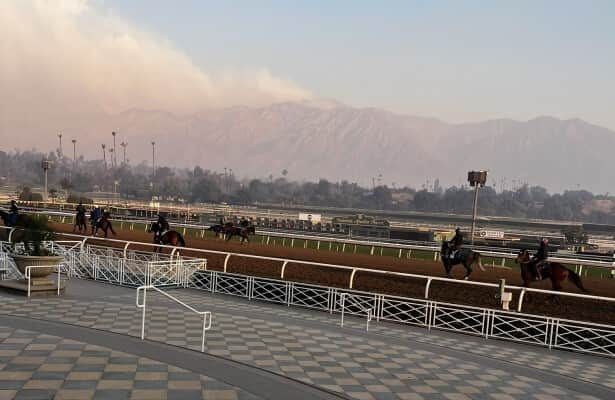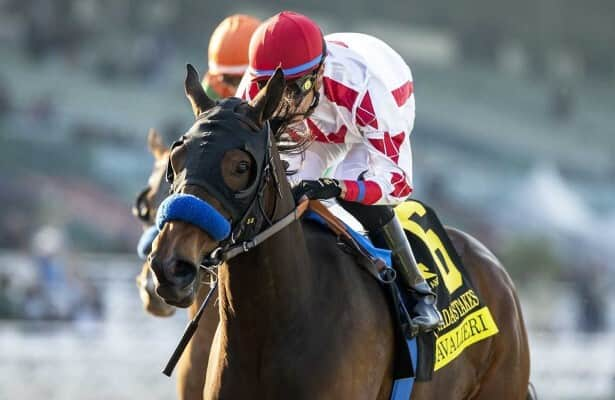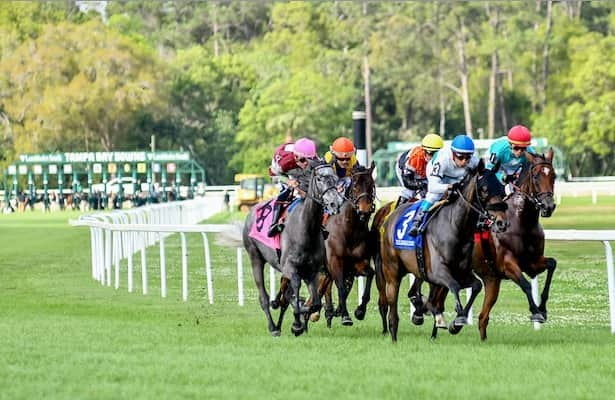Flatter: For Santa Anita, there is more than thoughts & prayers

The new year has reminded us just how fragile our lives can
be. Nine days ago it was New Orleans. This week it is Los Angeles.
Thoughts and prayers. It is that crutch of a phrase we utter
when words escape us. We say that when any attempt at eloquence is rendered feeble
by the gravity of flashpoints like Bourbon Street on Jan. 1 or the torture of the
Palisades and Eaton and Hurst and Sunset fires since Tuesday.
“Say what you’ve got to say, and then shut up.” That is what
the late radio icon Don Imus told John Minko before his first update at WFAN in
New York. Minko passed that edict along to everyone he trained, including me. The
phrase “thoughts and prayers” accomplishes that mission, even if it comes off
sounding dismissively hollow. We do not mean to be.
This week, this year, who among us has not offered real thoughts
and/or prayers? I found myself muttering them and uttering them when I thought
about races at Fair Grounds on New Year’s Day. I doubled down this week as the Southern
California wildfires trolled Santa Anita.
Since Wednesday there was a collective whew through the
stench of smoky air. Insensitive as it may have sounded while neighbors were
fighting for their lives and their ways of life, we all felt relief when we saw
the wind relent, and the flames did not touch Santa Anita. They thankfully
stayed away from the horses who depend on backstretch workers who depend on the
shelter of the track that provides them twice a month with a means to a livelihood.
There but for the grace of God. As images were being posted
on social media of how close the flames got to the racetrack and the stable
area that is not much more than a two-minute lick from the burning San Gabriel
foothills, all those what-ifs introduced themselves in my mind.
Where would racing go if Santa Anita were gone? We have
asked that question so much recently from economic and business and corporate points
of view. Colleagues with whom I have discovered geezerdom exchange predictions
all the time about how much longer California racing can last without a
lifeline of supplementary gambling dollars. For some long hours this week, that
scenario felt like it could be a moot point.
Yes, they could have raced at Los Alamitos, a dirt-only
course whose owner is 88. Aside from the few months Del Mar gets to be a
racetrack, it is anyone’s guess where turf horses would have gone. Someone
ought to check Golden Gate Fields to see if the weeds have grown through the
cracks there yet.
Fortunately, thanks to the wind dying down, that tin can got
kicked down the scorched road. For now.
Fire was the most tangible threat to a racetrack this week. Erosion,
though, is the bigger more enduring one. The crumbling infrastructure of the
sport cannot be ignored anymore. California is not a microcosm. It is the
macrocosm that takes in what ails so many other states.
One day and 3,000 miles from the fires that threatened its revered
West Coast equicenter, the Stronach Group let it be known that it wants the Florida
legislature to separate its racetrack and casino operations at Gulfstream Park.
It said it had the support of local horsemen, but that portrayal of a unified
front was shattered quickly by National Horsemen’s Benevolent and Protective Association
boss Eric Hamelback. He said decoupling racing and slot machines would be “detrimental
to the health and welfare of the horse-racing industry.”
The very name of the local supporters even came into dispute
when Hamelback pointed out that the HBPA moniker was not authorized for used by
this particular h.b.p.a. It was like Fairmount Park and FanDuel revisited. In a
move that resembled anything but a coincidence, the Florida Thoroughbred
Horsemen’s Association website and Facebook account looked Friday morning like
they had been suspended.
Before the name un-calling went down, the artist sometimes
known as the FTHA said it was sold on the idea that the proposed decoupling would
help Stronach get the financing to build a new casino and hotel at Gulfstream. These
owners and trainers collectively hope their support at the state capitol will be
made whole by a flow of more new money that Stronach would share with racing.
As FTHA executive director Herb Oster told Horse Racing
Nation’s Carolyn Greer, “It’s their bat and ball, right? So we really
decided that we have faith in them, and right or wrong, we’re not going to
block it.”
Through all that, three senior racing sources asked privately
if this strategy would lead to the sale of Gulfstream Park property to
developers who want nothing to do with running horses. Two of them, including
one with Florida ties, suggested that Stronach’s racing obligations could be
met by running about an hour up the road at the company’s Palm Meadows Training
Center. That would make for a mighty compact Pegasus party.
In all its media statements this week, Stronach has been
adamant that it has no plans to downsize racing at Gulfstream. In fact, it
believes this will grow it. Yet cynics find themselves emboldened by the downsizing
of Maryland racing with Stronach’s plans to unload Laurel Park after Pimlico is
reconstructed for the newfangled, government-run Maryland Jockey Club.
It is not just Stronach. Even as the New York Racing
Association rebuilds Belmont Park, days are numbered for Aqueduct. Turf
Paradise might have been a viable way station for humans and horses from
California, especially the north, if not for the fact the joint has been
falling apart for years under an unpopular, aging owner who wants out. The
promises of a casino at Hawthorne ring hollow like a check-is-in-the-mail
assurance to what remains of Chicagoland racing. Defiant as it has been against
federal regulation, Texas is treading water if not red ink.
Fortunately, racing has some bull markets. Kentucky is just
that thanks in large measure to historic horse-racing machines. New York and
Arkansas purses have been basking for years in their racinos’ revenue. Now it
looks like Virginia is on the vanguard with its flow of HHR dollars into more
race dates and a bigger calendar.
Just to show this is not about the familiar places showing
growth spurts, there is a movement backed with money from a Native American
tribe to bring back horse racing in Alabama for the first time in 30 years.
There also is a new track being built in Wyoming, the fourth there this century.
Talk about strange bedfellows. The new Thunder Plains Park east of Cheyenne and
its August meet are being financed by HHR and, believe it or not, the Stronach
Group.
Hope springs eternal. Out of what has been an awful start to
this new year in California, it seems like as good a time as any to count
blessings. It also is a proper time to solve problems. If Stronach and Del Mar
and the racing fairs can double down and convince their state government to
allow a flow of HHR money, then maybe there is hope out west.
Suggesting that Santa Anita can rise like a phoenix is too
trite. Instead, thoughts and prayers.
Ron Flatter’s column appears Friday mornings at Horse
Racing Nation. Comments below and at RonFlatterRacingPod@gmail.com are welcomed,
encouraged and may be used in the feedback segment of the Ron Flatter Racing Pod, which also is posted every Friday.
Related
Leading Parx jockey Sanchez will serve 7-day suspension
Photo: Jason Moran / Eclipse Sportswire Jockey Mychel Sanchez will serve a seven-day suspension and pay an additional $1,750 in fines
Bill Mott talks about plans for Sovereignty, Just F Y…
Photo: Gulfstream Park / Lauren King Sovereignty, dramatic late-running winner of the Fountain of Youth (G2) March 1, is being pointed
Up-and-coming Cavalieri chases Grade 1 glory in Beholder Mile
Photo: Santa Anita / Benoit Photo Cavalieri and Alpha Bella, who finished one-two in the Grade 3 La Cañada in January at Santa Anita,
4 stakes showcase shipping stars on Tampa Bay undercard
Photo: Gonzalo Anteliz Jr. / Eclipse Sportswire The stars will shine Saturday at Tampa Bay Downs, and not just in the Grade 3 Tampa Ba











